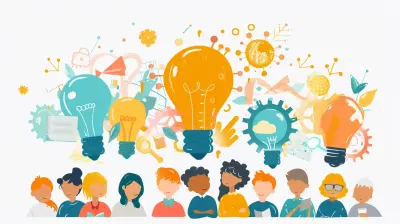Encouraging Student Voice and Choice in Learning
7 November 2025
Let’s be honest — when you think back to your school days, which lessons stuck with you the most? The ones where you were forced to sit still, absorb facts like a sponge, and repeat them back verbatim? Or the ones where you got to explore ideas, speak up, make choices, and bring a bit of “you” into the learning?
Exactly.
Education today is (finally!) shifting from a one-size-fits-all system to something a little more personal, meaningful, and, dare we say it, fun. Central to this shift is the idea of encouraging student voice and choice in learning. That’s not just education-speak for “let kids talk” — it’s about empowering them to take charge of their learning journey.
So, buckle in as we go on a light-hearted, engaging ride through why giving students a voice and a choice is a total game-changer!
What Does “Student Voice and Choice” Actually Mean?
Okay, let’s break this down.- Student Voice: This is all about students having a say in their education — expressing ideas, opinions, and feedback. It’s like giving them the mic and saying, “Your thoughts matter!”
- Student Choice: This part is giving them options in how, what, and even when they learn. Rather than following a rigid path, students get to pick routes that make the journey more interesting.
It’s like turning a fixed-menu dinner into a build-your-own buffet. Who wouldn’t prefer the buffet?
Why It Matters More Than Ever
We’re raising a generation swiping, clicking, scrolling — they’re used to autonomy in most parts of life. Then they hit the classroom and... boom. Worksheets. Silence. Sit-down-and-take-it-in learning.Yikes.
Giving students more voice and choice taps into something deeper — their sense of ownership. When students feel their opinions truly matter and that they have options, engagement skyrockets. And when engagement goes up, learning deepens.
It’s not just fluff — it’s backed by research and common sense.
The Magic of Motivation: Autonomy Breeds Engagement
Remember when you were a kid, and someone told you what not to do? What happened next? You did it, didn’t you? (We’re not judging.)That’s human nature. We don’t like feeling controlled. Students are no different.
When they’re given autonomy — meaning they can make certain decisions about their learning — they start to feel more responsible, more invested. It’s like giving them the keys to the car (okay, maybe just a tricycle at first). They might wobble or crash, sure, but they’re headed somewhere.
How to Empower Student Voice and Choice in the Classroom
Now for the juicy part. How do we actually encourage student voice and choice without turning the classroom into complete chaos?Let’s look at some practical, doable, and dare-we-say delightful strategies.
1. Let Them Set Goals
Instead of telling students what they need to achieve, why not co-create learning goals with them? You can help guide the conversation, but let them take the lead.Want to learn algebra? Cool. But what if a student loves architecture? Link equations to building stuff. Suddenly math isn’t miserable — it’s meaningful.
2. Offer Menu Boards (Not Just in the Cafeteria 🍕)
Create learning menus where students can choose how to demonstrate their understanding. That could mean:- Writing a short story
- Making a video or podcast
- Creating a presentation
- Designing an infographic
Different learning styles? Check. Creativity? Check. Ownership? Triple check.
3. Build in Reflection Time
Students may not always know what they want — especially younger ones. That’s okay. Help them find their voice by building in time to reflect on:- What they enjoyed
- What they struggled with
- What they’d change next time
It’s like being their own learning coach.
4. Flip the Script on Assessments
Traditional tests have their place. But why not offer options? Let students choose how they want to be assessed:- An oral presentation?
- An artistic representation?
- A hands-on project?
Same content, different pathways. It’s like choosing between riding a bike or a skateboard — the destination is the same, but the journey feels way more personal.
5. Start With Choice Boards
If giving total freedom scares you (understandably!), dip your toes in with choice boards.It’s simple: make a grid of activities. Each activity targets a learning objective, but students pick which ones to complete. Think academic bingo with a purpose!
But... What If They Choose the “Easy” Route?
Let’s address the elephant in the room. Will students always choose the path of least resistance?Maybe. Sometimes. But here’s the thing — even if they do, they’re still exercising decision-making skills. Over time, we can help guide them toward more challenging options. It’s all about building capacity and trusting the process, not forcing perfection right away.
Rome wasn’t built in a day, and neither are self-directed learners.
Voices That Matter: Encouraging Student Feedback
Too often, we ask students for feedback at the end of the year. That’s like asking how someone's meal was after they already paid the bill and left the restaurant.Instead, collect feedback throughout the learning process. Ask:
- “What’s working for you?”
- “What would you like to change?”
- “What helps you learn best?”
Then — and this is key — actually act on the feedback. When students see that we’re listening and adjusting, their voices only grow louder (in the best way).
Real-World Examples to Inspire You
Let’s shine a spotlight on a few schools and educators who are nailing this:- Genius Hour: Some classrooms dedicate time each week for students to explore passion projects. One student dives into coding, another researches climate change — suddenly, learning is alive and buzzing.
- Student-Led Conferences: Instead of the traditional parent-teacher talks, students lead the conversation, sharing their work, reflecting on progress, and setting new goals. Wow, right?
- Flexible Seating & Workspaces: Giving students literal choice in where and how they work (floor cushions, standing desks, quiet corners) can influence how they feel about their learning environment.
Tech Tools That Amplify Student Voice and Choice
Yes, technology can be a huge enabler here. And no, students don’t need to be tech wizards to benefit. Some simple tools and apps can make a big difference:- Padlet or Jamboard: Space for idea-sharing where every voice counts.
- Flip: Students can respond to prompts using videos — great for shy kids who hate raising their hand.
- Google Forms: Use them to gather feedback, votes on class activities, or topic interests.
When we use tech smartly, all voices get heard — not just the loudest in the room.
The Role of the Teacher: Guide on the Side (Not Sage on the Stage)
If all this sounds like we’re taking the control away from teachers — hold up. That’s not it at all.The teacher’s role becomes even more powerful, in a different way. You’re:
- A facilitator
- A coach
- A question-asker
- A safe space-holder
You construct the sandbox, but students get to build the castles (and sometimes dig a few holes).
How It Transforms the Classroom Culture
When student voice and choice become the norm instead of the exception, classrooms change. They become:- More inclusive
- More respectful
- More dynamic
- More connected
And the best part? Students start believing they can shape not just their education, but their world.
Suddenly, learning isn’t something done to them — it’s something done with them and for them.
Final Thoughts: It’s About Trust, Not Control
Encouraging student voice and choice might feel messy at first. It takes time, intention, and a little trial and error. But the payoff? Totally worth it.Because when students feel heard, empowered, and trusted, incredible things happen. They don’t just show up — they shine.
So go ahead — give them the mic, hand them the map, and let them chart their course.
After all, isn’t that what learning's really all about?
all images in this post were generated using AI tools
Category:
Teacher ResourcesAuthor:

Fiona McFarlin
Discussion
rate this article
1 comments
Alvin Franco
Great article! Empowering students to share their voices and make choices in their learning fosters engagement and ownership. It's inspiring to see how small changes can lead to meaningful impacts in classrooms. Keep up the awesome work!
November 16, 2025 at 1:08 PM

Fiona McFarlin
Thank you for your kind words! I'm glad you found the article inspiring. Empowering students truly makes a difference!


